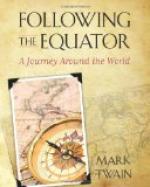CHAPTER LXVIII.
None of us can have as many virtues as the fountain-pen,
or half its cussedness; but we can try.
—Pudd’nhead
Wilson’s New Calendar.
The Duke of Fife has borne testimony that Mr. Rhodes deceived him. That is also what Mr. Rhodes did with the Reformers. He got them into trouble, and then stayed out himself. A judicious man. He has always been that. As to this there was a moment of doubt, once. It was when he was out on his last pirating expedition in the Matabele country. The cable shouted out that he had gone unarmed, to visit a party of hostile chiefs. It was true, too; and this dare-devil thing came near fetching another indiscretion out of the poet laureate. It would have been too bad, for when the facts were all in, it turned out that there was a lady along, too, and she also was unarmed.
In the opinion of many people Mr. Rhodes is South Africa; others think he is only a large part of it. These latter consider that South Africa consists of Table Mountain, the diamond mines, the Johannesburg gold fields, and Cecil Rhodes. The gold fields are wonderful in every way. In seven or eight years they built up, in a desert, a city of a hundred thousand inhabitants, counting white and black together; and not the ordinary mining city of wooden shanties, but a city made out of lasting material. Nowhere in the world is there such a concentration of rich mines as at Johannesburg. Mr. Bonamici, my manager there, gave me a small gold brick with some statistics engraved upon it which record the output of gold from the early days to July, 1895, and exhibit the strides which have been made in the development of the industry; in 1888 the output was $4,162,440; the output of the next five and a half years was (total: $17,585,894); for the single year ending with June, 1895, it was $45,553,700.
The capital which has developed the mines came from England, the mining engineers from America. This is the case with the diamond mines also. South Africa seems to be the heaven of the American scientific mining engineer. He gets the choicest places, and keeps them. His salary is not based upon what he would get in America, but apparently upon what a whole family of him would get there.
The successful mines pay great dividends, yet the rock is not rich, from a Californian point of view. Rock which yields ten or twelve dollars a ton is considered plenty rich enough. It is troubled with base metals to such a degree that twenty years ago it would have been only about half as valuable as it is now; for at that time there was no paying way of getting anything out of such rock but the coarser-grained “free” gold; but the new cyanide process has changed all that, and the gold fields of the world now deliver up fifty million dollars’ worth of gold per year which would have gone into the tailing-pile under the former conditions.




